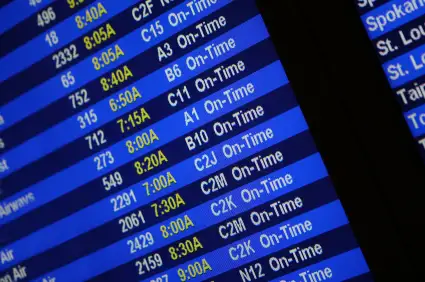
The Wall Street Journal‘s Scott McCartney posted a pretty fascinating column last week, detailing exactly how much extra time has been added to airline schedules over the past decade-and-a-half. It’s worth reading in full, but here are the highlights for the purposes of our discussion.
“Across the airline industry,” McCartney writes, “carriers have been adding minutes to ‘block times’—the scheduled durations—baking delays into trips so that late flights officially arrive ‘on time’ and operations run better because flights pull into gates more often on schedule. Even though the recession has led airlines to cut flights and reduce congestion at many airports and in the skies, the move to pump up schedules has continued: Last year, most airlines added padding to scores of flights.”
Want examples? McCartney has those, too. “Delta Air Lines Flight 715 from New York to Los Angeles now takes more than seven hours to fly across the country, according to the airline’s March schedule. That’s an hour longer than the same flight in the same type of aircraft took in 1996. A Phoenix-Las Vegas flight at Southwest Airlines that used to be scheduled at 60 minutes now gets 80 minutes. What was once a two-hour American Airlines trip from Chicago to Newark, N.J., now is two-and-a-half hours, according to the airline’s schedule.”
Some airlines implemented significant increases just in the past few years: “An early morning flight on United Airlines from Philadelphia to Los Angeles topped six hours of scheduled time by adding 15 minutes over the past three years; a Northwest Airlines flight, now part of Delta, had a 29-minute addition to its schedule from Detroit to Phoenix since 2007.”
Overall, McCartney checked 50 major U.S. routes across nine airlines, and found that flights were “17 minutes, or 10 percent, longer in airline schedules for this March compared to March 1996 schedules.” Of course, none of these cities are further apart than they were three or even 15 years ago. The delays are largely the result of congestion on the ground and an increasingly overwhelmed air traffic control system, although slower cruising speeds (to save fuel) and an increase in the use of slower regional jets both play a part.
From a consumer’s perspective, this creates a paradox: Even the most on-time airlines aren’t necessarily on time. Which is to say, their flights could take longer than they should, but you wouldn’t necessarily be able to tell by looking at your schedule. And as McCartney points out, padding route times helps improve those coveted on-time rankings monitored by the Department of Transportation (DOT), creating a false perception among the traveling public.
Of course, you may not care. The flip side to the issue—which the airlines are quick to point out—is that padding schedules results in more realistic expectations for passengers. After all, what does “on time” really mean? It means you get there when you’re supposed to. And if airport congestion is so bad that it affects this, shouldn’t that extra time be included in your itinerary?
I will leave you with this question: What do you think? Are the airlines cheating the system, and deluding their customers (and the DOT) with a false sense of punctuality? Or does schedule padding actually benefit travelers by providing a more honest sense of how long a trip will take? Leave a comment below with your thoughts.
We hand-pick everything we recommend and select items through testing and reviews. Some products are sent to us free of charge with no incentive to offer a favorable review. We offer our unbiased opinions and do not accept compensation to review products. All items are in stock and prices are accurate at the time of publication. If you buy something through our links, we may earn a commission.
Related
Top Fares From
Today's Top Travel Deals
Brought to you by ShermansTravel
France: 8-Night Paris, Avignon & Nice...
Infinity Worldwide Vacations
 vacation
$2880+
vacation
$2880+
Poconos: 3 Nts in Garden of...
ResortsAndLodges.com
 hotel
$305+
hotel
$305+
7-Nt Canada & New England Cruise,...
Princess Cruises
 cruise
$839+
cruise
$839+



